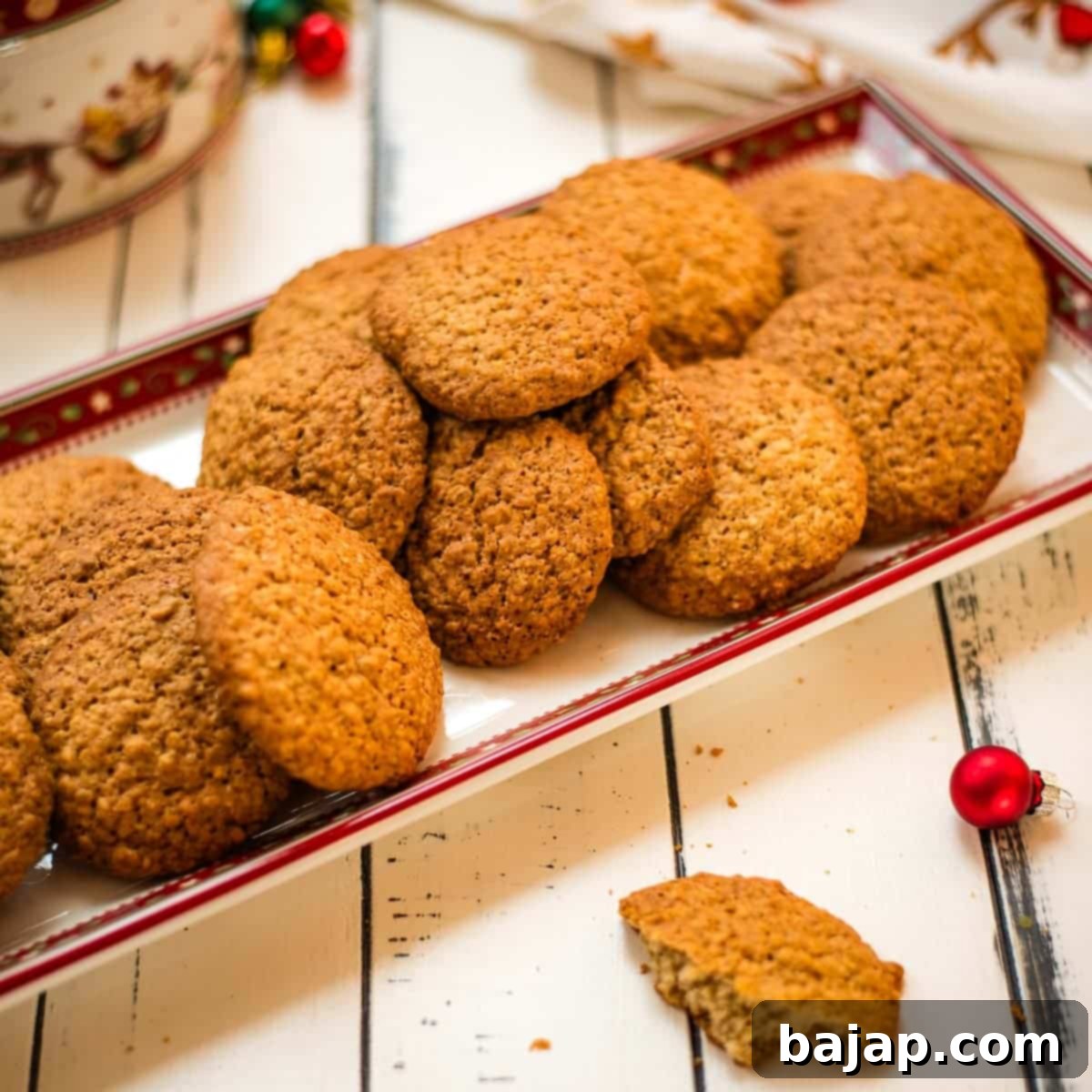Easy & Delicious Cinnamon Oatmeal Cookies: Your Favorite No Brown Sugar Recipe!
Imagine biting into a perfectly baked cookie, still warm from the oven. That’s exactly the experience these delightful cinnamon oatmeal cookies without brown sugar offer. Each bite is like a comforting, warm hug – a little moment of bliss in your day. They are wonderfully crispy on the edges and beautifully chewy in the center, striking that ideal balance that makes them utterly irresistible. It’s no wonder they’re my daughter’s absolute favorite, and truthfully, they might just become yours too!
What makes this recipe truly special, beyond its incredible taste, is its simplicity. It’s so straightforward that even my daughter loves to help out in the kitchen, making it a perfect activity for family bonding. You don’t need any fancy ingredients or complicated techniques to achieve bakery-quality cookies right at home. Plus, these aren’t just a fleeting treat; they boast an impressive shelf life when stored properly in a cookie jar. That means you can enjoy a delicious pick-me-up any time you need it after a long day – that is, if you can resist eating them all immediately!
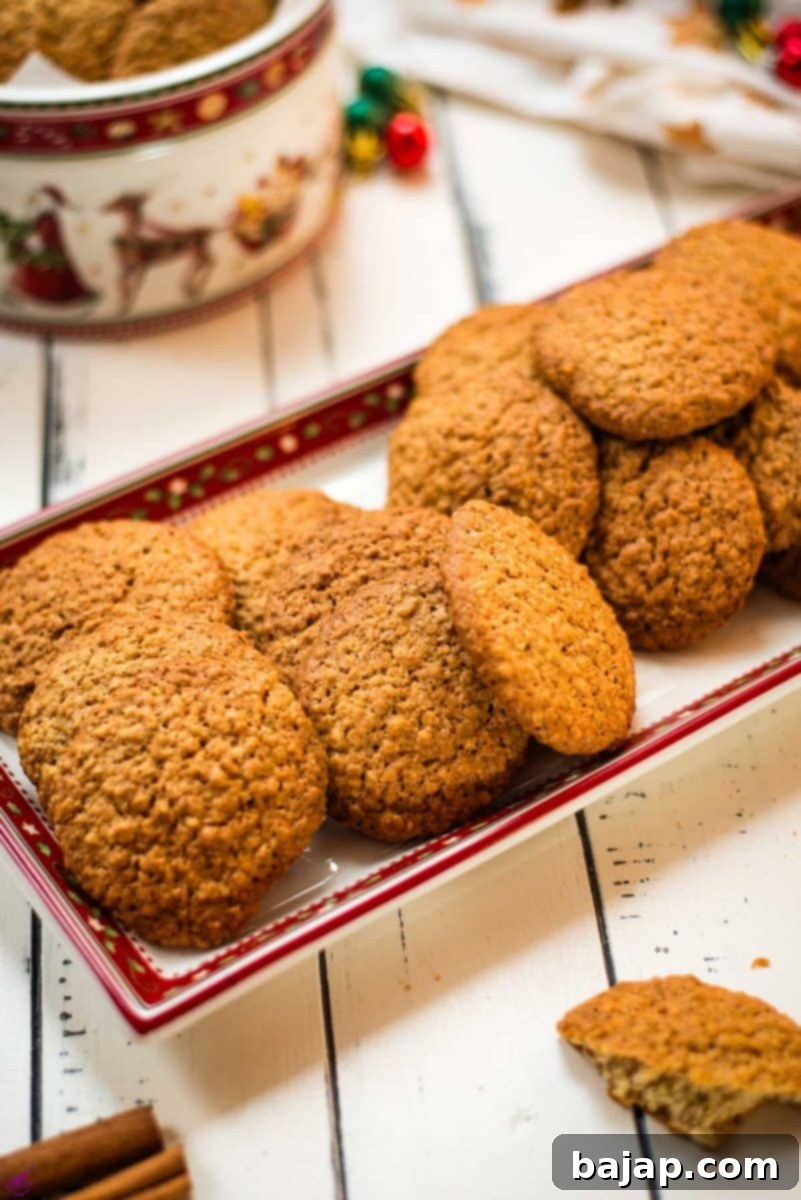
If you’ve ever found yourself craving homemade oatmeal cookies but realized you’re out of brown sugar, this recipe is your ultimate solution. We’ve mastered creating that rich flavor and delightful texture using alternative, readily available ingredients. The result is a batch of cookies that are just as satisfying, if not more so, than their brown-sugar counterparts. So, if you’re ready to dive into this delightful baking adventure and discover a new favorite, keep reading! You’re just a few steps away from experiencing pure cookie perfection.
[feast_advanced_jump_to]
🍪 Ingredients You’ll Need
Crafting these delicious cinnamon oatmeal cookies requires a selection of simple, wholesome ingredients. Don’t be fooled by the absence of brown sugar – our chosen substitutes ensure these cookies are packed with flavor and achieve that perfect texture you crave. Here’s a closer look at what you’ll need and why each component is essential:
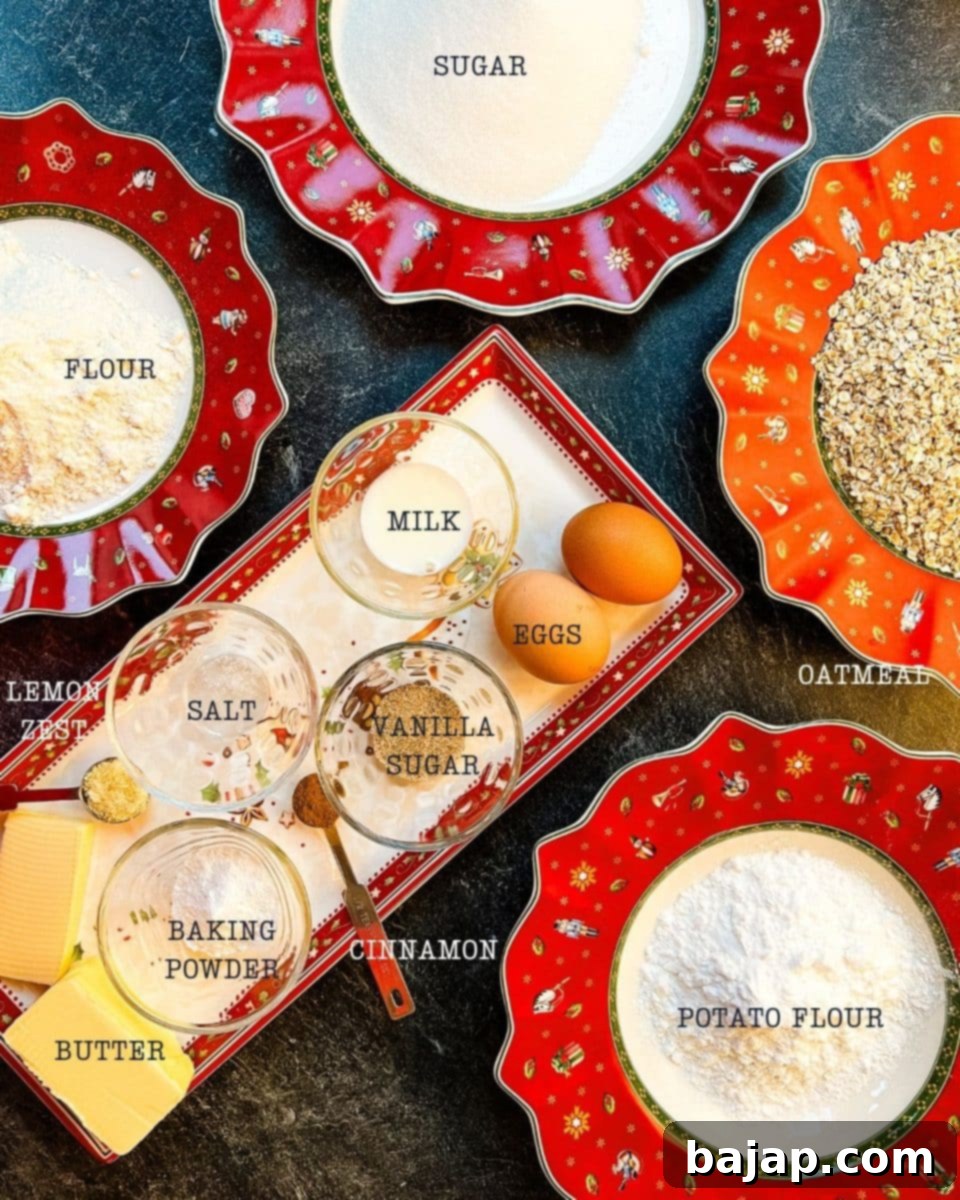
- Unsalted Butter (soft): Butter is the foundation of flavor and helps create that tender crumb. While our recipe melts it first, starting with softened butter ensures it melts smoothly and incorporates beautifully with the oats.
- Oatmeal: For the best texture, we recommend using old-fashioned rolled oats. They give the cookies a delightful chewiness and hearty structure that quick oats simply can’t match.
- Cake Flour: This lighter flour, with its lower protein content, is key to achieving a tender, delicate crumb in your cookies, preventing them from becoming too dense or tough.
- Baking Powder: Our leavening agent, responsible for giving the cookies a slight lift and contributing to their soft, yet crispy, texture.
- Potato Flour: This is a crucial ingredient in place of brown sugar. Potato flour helps retain moisture, adding to the cookies’ chewiness and binding power, which is essential when brown sugar’s molasses isn’t present to provide these qualities. It also contributes to a pleasant, delicate texture.
- Granulated Sugar: Provides the primary sweetness and helps with crisping the edges of the cookies.
- Vanilla Sugar (store bought or homemade): This adds a wonderful aromatic sweetness and a touch of gourmet flavor that complements the cinnamon beautifully. If you don’t have vanilla sugar, you can use regular granulated sugar plus a teaspoon of vanilla extract.
- Kosher Salt: A pinch of salt is vital for balancing the sweetness and enhancing all the other flavors in the cookie. Don’t skip it!
- Ground Cinnamon: The star spice of these cookies! Reach for Ceylon cinnamon when buying. Ceylon cinnamon, often referred to as “true cinnamon,” offers a milder, more nuanced, and fragrant flavor compared to common Cassia cinnamon. More importantly, Ceylon cinnamon contains hardly any Coumarin. In large amounts, Coumarin can be toxic, especially for pregnant women, making Ceylon a safer and more flavorful choice.
- Lemon Zest: A delightful secret ingredient! Lemon zest provides a bright, fresh note that cuts through the sweetness and enhances the overall flavor profile, making the cinnamon pop even more.
- Eggs: Act as a binder, provide structure, add moisture, and contribute to the richness and golden color of the cookies.
- Milk: Helps bring the dough together, ensuring it has the right consistency for scooping and baking.
For precise measurements and detailed quantities, please refer to the recipe card below.
🔪 Step-by-Step Baking Instructions
Making these cinnamon oatmeal cookies is a breeze, even for novice bakers. Follow these clear and concise steps to create a batch of perfectly baked, incredibly flavorful cookies that you’ll be proud to share (or keep all to yourself!).
- Melt the Butter: The first step to getting started on these delicious oatmeal cookies is to melt your softened butter in a small saucepan over low heat. Be careful not to brown the butter; we want it just melted and warm.
- Combine Oats and Butter: Next, transfer your oatmeal to a medium mixing bowl. Pour the hot melted butter directly over the oats. Mix immediately until the butter is completely absorbed and the oatmeal is well combined and coated. This step helps soften the oats slightly and infuses them with rich butter flavor.
- Sift Dry Ingredients: Once the butter and oatmeal are combined, use a sieve to sift in your cake flour and baking powder directly over the mixture. Sifting prevents lumps and ensures these dry ingredients are evenly distributed, leading to a more consistent cookie texture.
- Add Remaining Dry Ingredients: After sifting, add the rest of your dry ingredients to the oatmeal mixture: potato flour, granulated sugar, vanilla sugar, kosher salt, ground cinnamon, and lemon zest. The potato flour is key here, contributing to the desired chewiness and moisture that brown sugar typically provides.
- Incorporate Wet Ingredients: Now, add the eggs and milk to the bowl. Attach a flat beater to your electric mixer and mix the ingredients on a low to medium speed until a cohesive dough forms. Be careful not to overmix; mix just until everything is well combined.
- Preheat Oven and Prepare Baking Sheets: Before you start forming your cookies, preheat your oven to 180 °C / 356 °F. Line a baking tray with baking paper (parchment paper) to prevent sticking and ensure easy cleanup.
- Scoop and Bake: Using a small cookie scoop (a 1-tablespoon size is ideal for the yield mentioned in this recipe), scoop out uniform portions of the oatmeal mixture. Place them on the prepared baking sheet, ensuring there’s enough space between them for even air circulation and spreading during baking (aim for about 5 rows with four cookies per row). Bake for 25-30 minutes, or until the edges are lightly golden brown and the centers are set. The exact time may vary slightly depending on your oven and cookie size.
- Cool and Enjoy: Once your cookies have reached that perfect golden-brown color, remove the baking sheet from the oven. Carefully transfer the hot cookies to a wire rack to cool completely. Resist the urge to dig in right away! Cooling allows the cookies to firm up and develop their full flavor and texture. After they’ve cooled down sufficiently, all that’s left to do is say, “Bon Appetit!”
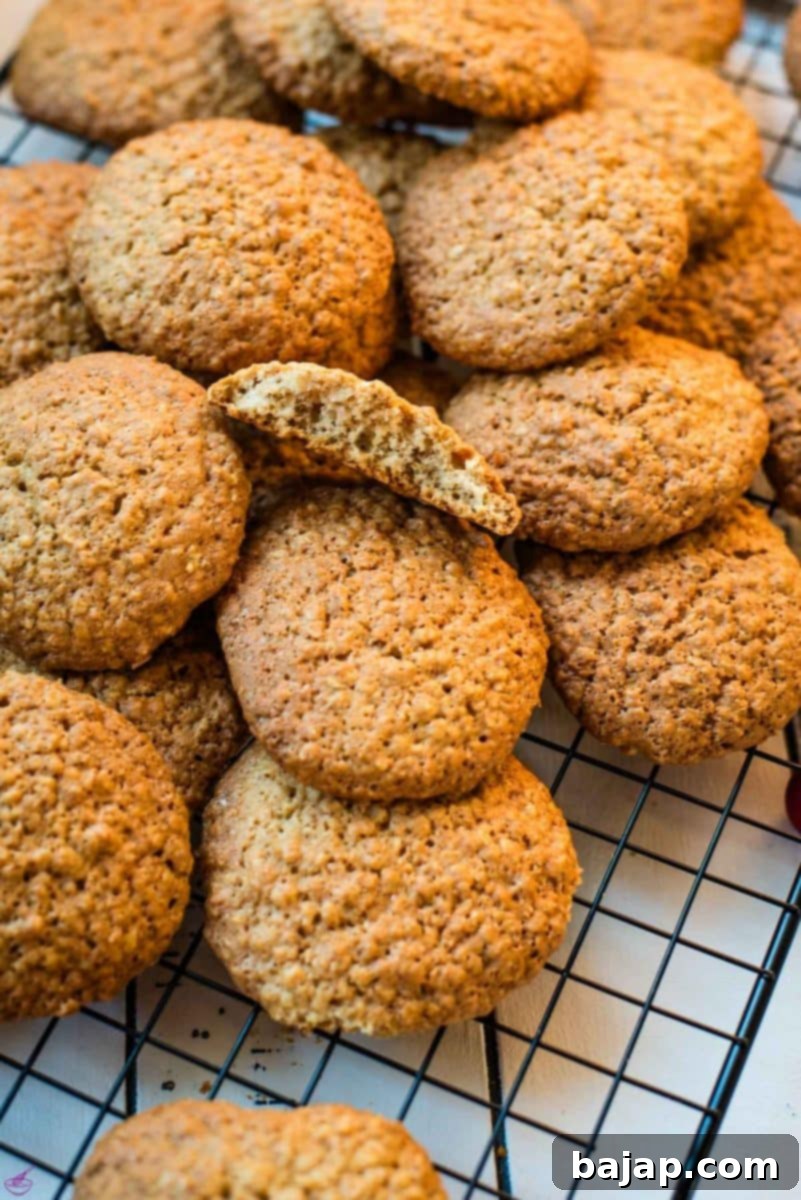
These incredibly satisfying cookies pair perfectly with a delicious cup of sage tea, offering a soothing contrast to the sweet cinnamon notes. Discover how to make your own aromatic sage tea here!
🍪 Creative Cookie Variations
While these cinnamon oatmeal cookies are perfect as is, they also serve as a fantastic canvas for your culinary creativity! Don’t hesitate to experiment with different mix-ins and flavor enhancements to customize each batch to your liking. Here are some popular and delicious variations you can try:
- Fruity Additions: Easily vary this recipe by adding extra dried fruits to the dough. Classic choices include plump raisins, tangy dried cranberries, finely chopped dried apricots, or even diced candied ginger for a spicy kick. Add about ½ to 1 cup of your preferred dried fruit along with the other dry ingredients.
- Nutty Crunch: For added texture and a rich, earthy flavor, incorporate about ½ cup of chopped nuts. Walnuts and pecans are traditional favorites for oatmeal cookies, but almonds or hazelnuts would also be delicious. Lightly toasting the nuts beforehand can really bring out their flavor.
- Chocolate Indulgence: Who can resist chocolate? Stir in ½ to ¾ cup of your favorite chocolate chips – milk chocolate, dark chocolate, white chocolate, or even a mix of all three! Chopped chocolate bars also work wonderfully for a more gourmet feel.
- Spice it Up: Enhance the warm spice profile by adding a pinch of other complementary spices. A ¼ teaspoon of nutmeg, allspice, or ground ginger can elevate the cinnamon flavor. For a festive twist, try a teaspoon of pumpkin pie spice blend.
- Citrus Swaps: While lemon zest offers a bright counterpoint, orange zest can also be used for a sweeter, more aromatic citrus note.
- Extract Excitement: A few drops of almond extract, maple extract, or even a hint of rum extract can introduce new dimensions of flavor.
- Decorative Touches: After baking and cooling, consider drizzling the cookies with a simple vanilla glaze (powdered sugar + milk/vanilla) or sprinkling them with a mixture of cinnamon sugar for an extra flourish.

Christmas CookieBook!
Snag that Recipe eBook!
Unlock the magic of holiday baking with our exclusive Christmas CookieBook! Featuring 20 delicious Christmas Cookie recipes, it’s your go-to guide for festive treats. Perfect for sharing with family and friends or simply indulging yourself!
Yes, please!
🍽 Essential Baking Equipment
Having the right tools can make all the difference in your baking experience. While you don’t need a professional kitchen, a few key pieces of equipment will ensure smooth sailing when making these oatmeal cookies. Here’s what we recommend:
- Electric Mixer (with flat beater attachment): Essential for efficiently combining ingredients and forming a smooth, uniform dough. A stand mixer or a good quality hand mixer will both work beautifully.
- Small Saucepan: For melting the butter. Its small size makes it easy to manage the butter without it browning too quickly.
- Sieve: Crucial for sifting the cake flour and baking powder, preventing any lumps and ensuring a light, even texture in your cookies.
- Cookie Scoop: This is a game-changer for uniform cookies! I always have three different cookie scoop sizes at home – 1 tablespoon / 0.5 oz, 2 tablespoon / 1 oz, and 3 tablespoon / 1.5 oz. For this recipe, the 1-tablespoon cookie scoop is the one I use most often, as baking times and cookie quantities are adjusted to this size, yielding approximately 50 cookies. If you prefer larger cookies, feel free to use the larger sizes, but keep in mind that the baking time will increase, and the number of cookies will decrease. Uniform cookies ensure even baking, so none are over or undercooked.
- Mixing Bowl: A large mixing bowl is necessary to comfortably combine all your ingredients without spills.
- Baking Tray/Sheet: You’ll need at least one, possibly two, to bake all your cookies. Standard half-sheet pans work best.
- Baking Paper (Parchment Paper): Lines the baking tray, preventing cookies from sticking and making cleanup incredibly easy.
- Wire Rack: An absolute must for cooling your cookies. It allows air to circulate around them, preventing soggy bottoms and ensuring they cool evenly and maintain their crispness.
🌡 Storage Tips for Freshness
One of the best things about these delicious cinnamon oatmeal cookies (besides their flavor!) is their excellent shelf life. With this recipe, you’ll have about 50 cookies, so you’ll likely wind up with some leftovers – which is great news for future cravings!
To keep your cookies fresh and delightful for as long as possible, store them in an airtight container at room temperature. A cute cookie jar isn’t just for aesthetics; it truly helps maintain their texture and flavor. Stored this way, these cookies can last for up to several weeks! For best results, you can also place a slice of bread in the cookie jar. The bread will absorb any excess moisture, helping to keep the cookies soft and fresh.
If you’re planning ahead or want to save some for an even later date, you have a couple of options:
- Freezing Baked Cookies: Once completely cooled, place the cookies in a single layer on a baking sheet and freeze for about 30 minutes until solid. Then, transfer them to a freezer-safe airtight container or heavy-duty freezer bag, separating layers with parchment paper to prevent sticking. They can be frozen for up to 2-3 months. Thaw at room temperature or gently warm them in the oven for a “freshly baked” experience.
- Freezing Cookie Dough: You can also prepare the dough, scoop out individual cookie balls, and place them on a parchment-lined baking sheet. Freeze until solid, then transfer the frozen dough balls to a freezer-safe bag. When you’re ready to bake, simply place the frozen dough balls on a baking sheet and add a few extra minutes to the baking time. This way, you can enjoy freshly baked cookies anytime!
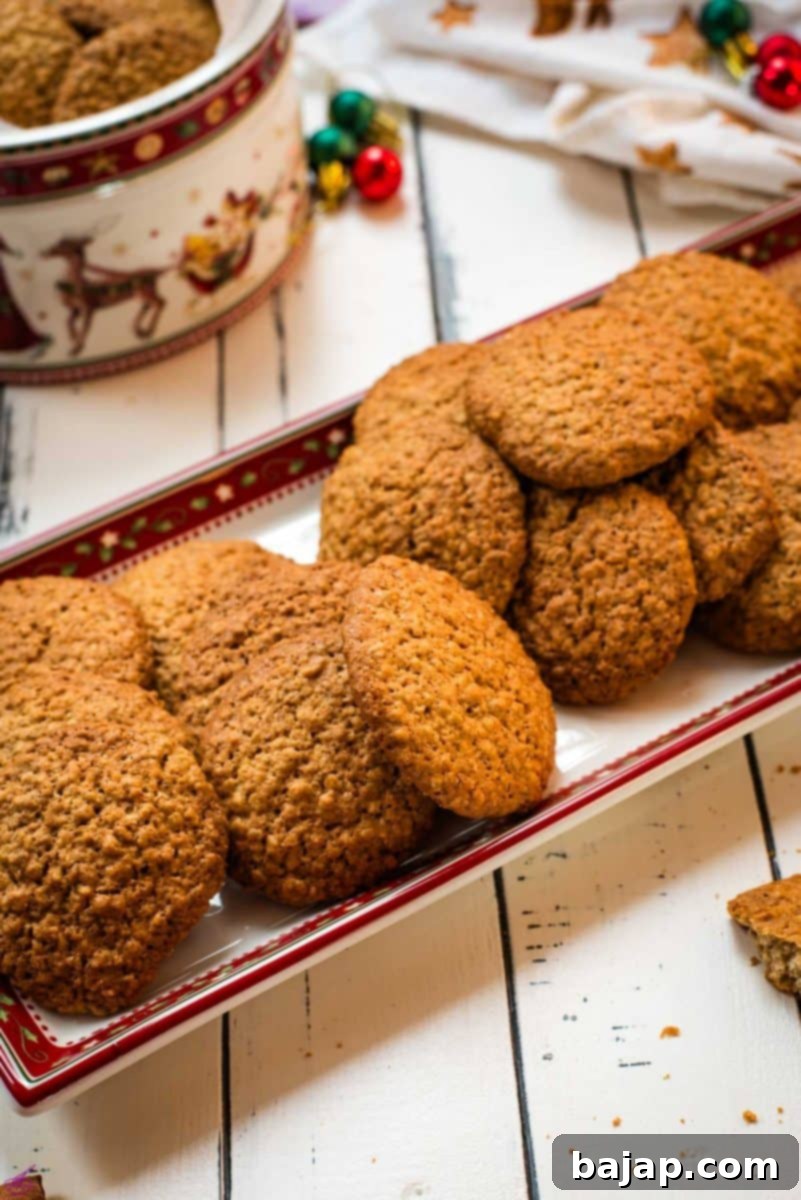
💭 Understanding Brown Sugar’s Role in Baking
Brown sugar is a type of sugar that gets its distinct flavor and light brown hue from the molasses mixed into it. This molasses content is what sets it apart from white granulated sugar, offering a richer, deeper sweetness with a subtle caramel-like note. It’s often considered more versatile than white sugar, especially in baked goods where a complex flavor or a softer, chewier texture is desired.
The molasses in brown sugar is hygroscopic, meaning it attracts and retains moisture. This is why recipes using brown sugar often result in baked goods that are softer, chewier, and stay moist for longer. Dark brown sugar contains more molasses than light brown sugar, making it denser and richer in flavor. When substituting brown sugar in a recipe, it’s important to consider not just the sweetness, but also the moisture and textural contributions it brings. Adjusting the amount of liquid or adding ingredients that mimic its moisture-retaining properties, like the potato flour in this recipe, is key to successful substitution.
While brown sugar plays a significant role in many cookie recipes, this cinnamon oatmeal cookie recipe proves that it’s absolutely possible to achieve incredible results without it. By cleverly utilizing ingredients like potato flour, we can replicate the desirable moisture, chewiness, and delightful texture that bakers typically associate with brown sugar, ensuring your cookies are nothing short of perfect!
🎄 Get in the Christmas Mood
If these cozy cinnamon oatmeal cookies have you dreaming of festive cheer, explore more of our holiday-inspired content to get fully into the Christmas spirit!
- How to Decorate a Real Christmas Tree in 11 Steps
- Baking Basics for Christmas Cookies
- Delicious No Churn Egg Liqueur Parfait
- Cranberry Aperol Spritz
🙋🏻 Frequently Asked Questions
In this particular recipe, we’ve successfully used a combination of potato flour, granulated sugar, and vanilla sugar to achieve a texture and sweetness profile similar to what brown sugar would provide. The potato flour is key for moisture and chewiness. Other variations include adding a tablespoon of molasses to white granulated sugar to create your own “brown sugar” substitute, or incorporating liquid sweeteners like honey or maple syrup. However, if using liquid sweeteners, you might need to slightly adjust the dry ingredients to maintain the right dough consistency.
Without brown sugar, cookies typically tend to be crispier and less chewy, as the molasses in brown sugar is responsible for its moisture-retaining properties and unique texture. They might also spread differently and lack the deep, caramel-like flavor. However, this recipe is specifically designed to counteract those potential issues. By using ingredients like potato flour and a balanced combination of granulated and vanilla sugars, we ensure these oatmeal cookies still achieve a delightful crisp-chewy texture and rich flavor, proving you absolutely can make fantastic cookies without brown sugar.
While brown sugar is highly valued in many cookie recipes for its contribution to moisture, chewiness, and a richer flavor, it is certainly not always necessary. This recipe is a perfect example of how clever ingredient substitutions can achieve equally delicious results. The key is understanding what brown sugar brings to the table (moisture from molasses, a slightly acidic pH, and caramel notes) and finding other ingredients that can provide similar attributes or create a desirable alternative texture.
Brown sugar serves several important purposes in cookie recipes. Its molasses content makes cookies soft, moist, and delightfully chewy. The molasses also contributes to a richer, more complex flavor profile with notes of caramel. Additionally, brown sugar is slightly more acidic than white sugar, which can react with baking soda to provide lift and contribute to a softer crumb. Its presence also influences how cookies spread and brown, often leading to a more golden hue and a tender interior.
Ceylon cinnamon, also known as “true cinnamon,” is recommended for its superior flavor profile, offering a more delicate, sweet, and complex aroma compared to the stronger, spicier Cassia cinnamon. More importantly, Ceylon cinnamon contains significantly lower levels of Coumarin, a natural compound found in higher concentrations in Cassia cinnamon that can be harmful to the liver in large doses. Opting for Ceylon cinnamon provides a safer and more refined taste experience, especially if you enjoy baking with cinnamon frequently.
More Delicious Cookie Recipes to Explore
Loved these oatmeal cookies? Then you’ll definitely want to check out these other fantastic cookie recipes from our collection!
- Delicious, Super Quick M and M Cookies
- Austrian Coconut “Busserl” cookies – Like from Granny
- Divine Leftover Egg Yolk Cookies
- 5 Ingredient Raspberry Cheesecake Thumbprint Cookies
- Chocolate Chip Cookies with Chestnut Flour
If you make this recipe, I would absolutely love to know how you liked it! Please consider leaving a ★★★★★ star rating and a comment below. Your feedback is truly awesome and helps others discover these wonderful cookies! You can also sign up for our Newsletter or follow me on Pinterest or Instagram and share your creation with me. Just tag me @combinegoodflavors and use the hashtag #combinegoodflavors, so I don’t miss seeing your delicious baking!
📖 Recipe Card
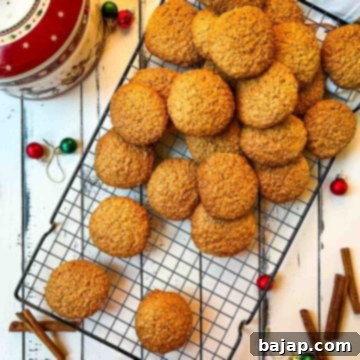
Oatmeal Cinnamon Cookies without Brown Sugar
Nora
Save RecipeSaved!
Pin Recipe
Equipment
-
Electric Mixer (with flat beater attachment)
-
Saucepan small
-
Sieve
-
Cookie scoop
-
Mixing bowl
-
Baking tray
-
Baking Paper
-
Cooling Rack
Ingredients
- ½ Cup Unsalted Butter softened
- 3 ¼ Cup Old-Fashioned Rolled Oats
- 1 Cup Cake flour
- 3 ¼ teaspoon Baking powder
- 1 Cup Potato flour
- 1 Cup Granulated sugar
- 2 teaspoon Vanilla sugar
- 1 dash Kosher salt
- ½ teaspoon Ground Ceylon Cinnamon
- 1 teaspoon Lemon zest
- 2 Large Eggs
- 3 tablespoon Milk
Instructions
-
Melt ½ Cup Unsalted Butter in a small saucepan over low heat until just melted. Do not allow it to brown.½ Cup Unsalted Butter
-
Place 3 ¼ Cup Old-Fashioned Rolled Oats in a mixing bowl. Pour the hot melted butter over the oats and mix thoroughly until the butter and oatmeal are well combined and the oats are fully coated.3 ¼ Cup Old-Fashioned Rolled Oats
-
Using a sieve, sift 1 Cup Cake flour and 3 ¼ teaspoon Baking powder into the oatmeal mixture.1 Cup Cake flour, 3 ¼ teaspoon Baking powder
-
Add the remaining dry ingredients to the oatmeal mixture: 1 Cup Potato flour, 1 Cup Granulated sugar, 2 teaspoon Vanilla sugar, 1 dash Kosher salt, ½ teaspoon Ground Ceylon Cinnamon, and 1 teaspoon Lemon zest.1 Cup Potato flour, 1 Cup Granulated sugar, 2 teaspoon Vanilla sugar, 1 dash Kosher salt, ½ teaspoon Ground Ceylon Cinnamon, 1 teaspoon Lemon zest
-
Add 2 Large Eggs and 3 tablespoon Milk. Using an electric mixer with a flat beater attachment, mix on low speed until a soft, cohesive dough forms. Avoid overmixing.2 Large Eggs, 3 tablespoon Milk
-
Preheat your oven to 180 °C / 356 °F (convection oven setting if available). Line a baking tray with baking paper (parchment paper).
-
Using a small cookie scoop (approximately 1 tablespoon size), portion out cookies from the oatmeal mixture. Place them on the prepared baking sheet, ensuring adequate space between each cookie (aim for about 5 rows with four cookies per row). Bake for 25-30 minutes, or until the edges are beautifully golden brown.
-
Carefully transfer the baked cookies to a wire rack and allow them to cool completely. This step is crucial for the cookies to firm up and develop their ideal crispy-chewy texture.
Nutrition values are estimates only, using online calculators. Please verify using your own data.

🤎 You Might Also Like
If you enjoyed this delightful oatmeal cookie recipe, here are more delicious cookies and baked goods to satisfy your sweet tooth!
- Chocolate Chip Cookies with Chestnut Flour
- Chocolate Dipped Butter Cookies
- Sour Cream Cookies with Pearl Sugar
- Easy Cut-Out Sugar Cookies {no chill}
⛑️ Important Food Safety Guidelines
Ensuring food safety in the kitchen is paramount to enjoying your delicious creations without worry. Please keep these essential guidelines in mind when baking:
- Cook all food to a minimum safe internal temperature of 165 °F (74 °C) to eliminate harmful bacteria. While cookies are generally baked at higher temperatures, ensuring any additional fillings or mix-ins are also safe is crucial.
- To prevent cross-contamination, never use the same utensils or cutting boards on cooked food that previously touched raw meat, poultry, or eggs (before they are fully incorporated into the dough).
- Always wash your hands thoroughly with soap and warm water for at least 20 seconds after handling raw eggs, unbaked dough, or any other raw ingredients.
- Do not leave perishable food items, including cookie dough containing raw eggs, sitting out at room temperature for extended periods (typically no more than two hours). Promptly refrigerate or freeze as instructed.
- Never leave cooking food unattended on the stovetop or in the oven. Always be present to monitor the baking process and prevent overcooking or potential hazards.
- When cooking or baking at high temperatures, consider using oils with high smoking points to avoid the formation of harmful compounds, although this recipe primarily uses butter.
- Always ensure good ventilation in your kitchen, especially when using a gas stove, to prevent the buildup of fumes and improve air quality.
For further comprehensive information and guidelines on safe food handling, please consult reputable sources like the Safe Food Handling – FDA website.
